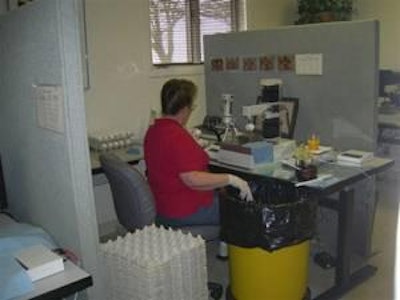
Both internal and shell quality as significant variables influencing consumer appeal rank highly in the Hy-Line selection program. Recently Egg Industrywas invited to view laboratory procedures applied by the company in their dedicated facility in Dallas Center, Iowa.
Hy-Line evaluates quality from a range of generations in the breeding program but also from flocks placed on commercial farms in the U.S., Brazil and the UK. The egg evaluation laboratory processes over 1 million eggs annually and enters results of assays into an extensive database which is then applied in the program of selection of sire and dam families.
All eggs submitted for evaluation are identified with an adhesive barcode tag coding for generation, strain, location and other relevant details. Special software has been developed to relate the barcode data with the physical measurements of quality.
External quality measured
Trained operators process eggs using automated instruments to achieve a high standard of accuracy and consistency. The following measurements are obtained through a sequence of stations:
- Egg shell color is determined using a Minolta colorimeter which determines the L*a*b variables comprising the color index. Both white and brown shell eggs can be evaluated and the extent of “speckling” is scored on brown shelled eggs.
- Shell quality is measured using a compression instrument which determines the force required to puncture the shell in standardized locations around the circumference. The breaking strength of shells is also determined using a force meter with a disc-shaped head.
- Egg weight is determined using a sensitive scale accurate to within 0.1 gram.
The integrity of the shell is assessed using a specially constructed electronic instrument which functions similar to the crack detector on a grader but with far greater sensitivity.
Internal characteristics checked
After obtaining the external quality characteristics, eggs are broken for the following determinations:
- Albumen height is measured at a specific location midway between the vitaline membrane and the outer circumference of the thick albumen.
- Internal quality is monitored by observing for the presence of protein inclusions which are translucent to ivory in color in white shelled eggs and are pigmented (“meat spots”) in brown-shelled eggs.
- Yolk weight is determined using a second sensitive scale as this parameter relates to the relative proportions of albumen and yolk as a function of egg mass and the proportion of solids.


















